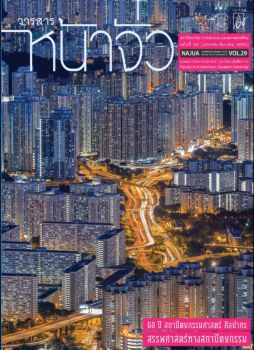คติความเชื่อ: แกนหลักในการอนุรักษ์สถาปัตยกรรมเรือนพื้นถิ่น กลุ่มชาติพันธุ์ลาหู่ กรณีศึกษา ดอยมูเซอ จังหวัดตาก
Keywords:
การตั้งถิ่นฐาน, เกลือ, อีสาน, ตะวันออกเฉียงเหนือAbstract
พื้นที่จังหวัดตาก มีกลุ่มชาติพันธุ์หลากหลายชาติพันธุ์ตั้งถิ่นฐานมาแต่ดั้งเดิม และเคลื่อน ย้ายมาจากหลายแหล่งในประเทศไทยและประเทศใกล้เคียง จากการสำรวจสภาพสถาปัตยกรรม เรือนพื้นถิ่นของกลุ่มชาติพันธุ์ที่อยู่อาศัยในพื้นที่บริเวณดอยมูเซอพบว่า เรือนพื้นถิ่นของกลุ่มชาติพันธุ์ส่วนใหญ่กำลังสูญหายไปจากพื้นที่ อันเนื่องมาจากอิทธิพลของวัสดุก่อสร้างสมัยใหม่ สภาพเศรษฐกิจ ของสังคมเมือง และการสื่อสารที่ไร้พรมแดน ที่ส่งผลให้มีสภาพชีวิตความเป็นอยู่ที่เปลี่ยนไปและการ เปลี่ยนแปลงสถานะทางสังคมของกลุ่มชาติพันธุ์ อย่างไรก็ตาม พบว่ากลุ่มชาติพันธุ์ลาหู่ เป็นชนกลุ่ม หนึ่งที่ยังคงรักษารูปแบบสถาปัตยกรรมดั้งเดิมไว้ได้ จากการศึกษาพบว่าคติความเชื่อของกลุ่มชาติพันธุ์ มีผลอย่างมากต่อการรักษารูปแบบทางสถาปัตยกรรมพื้นถิ่น ความเชื่อนี้ได้ส่งผลต่อรูปแบบการจัดวางผังเรือนในชุมชน และการใช้สอยพื้นที่ภายในตัวเรือน
Traditional beliefs: the major influence on the preservation of the traditional ethnic groups’ houses: the Lahu ethnic group, Doi Muser, Tak province
Watcharin Jinwuth, Ph.D.
Assistant Professor, Faculty of Architecture, Naresuan University
There are various ethnic groups located in Tak province, many who have been resident for a long period together with those who have immigrated recently from various parts of Thailand and surrounding countries. The result of a study of vernacular houses located at Doi Muser (Muser Hill) has found that the traditional architecture of most of vernacular houses is disappearing due to the influences of new construction methods and materials, the economy and borderless communications. This transformation has resulted in changes to their lifestyles and a change to people’s social status. However, the Lahu Tribe is one of the ethnic groups who still maintain their traditional architecture for vernacular houses. The study has revealed that traditional beliefs are the major influence on the preservation of the traditional architecture. It has also affected both urban planning and functional planning of the ethnic groups.





